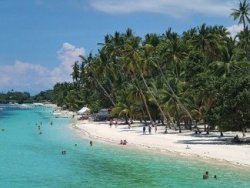Philippines Tourist Arrivals Boosted by Improved Facilities
Philippines tourist arrivals continue to grow
If you build it, they will come.
About three million tourists, lured by better infrastructure, a liberalized airline industry and improved facilities, flocked to the Philippines in 2009. Only half of that number came in the whole 2001.
The President has always believed that tourism is a major creator of jobs and livelihood opportunities.
As early as her first State of the Nation Address, the President let the country in on her field of dreams. She said the Philippines, with its natural wonders and warmth of its people, has an edge over its neighbors. She added then that she would provide roads to those wonders and the means to take any Philippines tourist there. She also talked boldly about liberalizing the airline industry.

Philippines Tourist Spot - Panglao Bohol
At that time, the world had known the Philippines only for Boracay, Palawan and Cebu.
Feeling a need to reintroduce the country to the world, the President ordered the Department of Tourism to find a way of increasing market share in the booming tourism industry of Southeast Asia. She insisted that the agency develop the Southeast and Far East Asian markets in addition to the traditional U.S. market.
The strategy has paid off. The biggest numbers of tourists now come from neighboring Asian countries, with Koreans topping the list for several years. Also impressive is the 500 percent growth since 2001 of tourists from China.
Domestic tourism also increased, along with foreign tourism due in part to the efforts of the government in partnership with the private sector to provide Philippines tourist infrastructure and facilities.
P555 Billion Investments for Philippines Tourist
From 2004 to August this year, P555 billion worth of investment went to the development of transportation, tourism eco-zones, accommodations and other related facilities. It is these investments that have enabled the country to increase Philippines Tourist Arrivals and its share in the Southeast Asian tourism industry.
Of course, the construction of roads, bridges, airports, and seaports, which falls under the President’s Super Regions Economic Strategy, was undertaken to spur and sustain growth primarily in industry and agriculture, but the tourism sector has benefited immensely from the ambitious infrastructure development program.
The liberalization of the airline industry has resulted in the opening of air routes to and from major tourist markets, including Incheon, Busan, Shanghai, Guangzhou, and Kaohsiung.
Aggressive Promotion to Philippines Tourist
While national government created the infrastructure, the Department of Tourism escalated its tourism investment promotions, encouraging establishments to build more hotels and other facilities. A variety of financing schemes and a stronger pitch for tourism investments facilitated the building of new hotels and other facilities in favorite destinations and in up-and-coming tourist attractions.
With the rise in the number of tourist arrivals comes an increase in job opportunities. Employment in tourism and related industries accounts for almost 10 percent of total employment. The industry directly employs more than three million Filipinos now, up from one million it did in 2001.The industry has merely doubled but it has created three times the number of jobs.
Tourism Act Consolidates Gains
Otherwise known as Republic Act (RA) 9593, the Act is designed to strengthen the strategic partnership between the government and the private sector.
Signed into law by the President, the Act reorganizes the Philippine Convention and Visitors Corporation (PCVC) into the Tourism Promotions Board (TPB), a corporate body responsible for the marketing and promotion of the country as a global tourism destination by highlighting its tourism products and services.
Meanwhile, the Duty Free Philippines (DFP) will become the Duty Free Philippines Corporation (DFPC), a body corporate mandated to operate the duty and tax-free merchandising system in the country.
It establishes "tourism enterprise zones" in strategic areas, including Cebu, Davao, Bohol, Laguna, Cavite, Boracay, Palawan and Iloilo, to lure foreign investors and tourists to visit places rich in history and culture. (Presidential News Desk/OPS)


